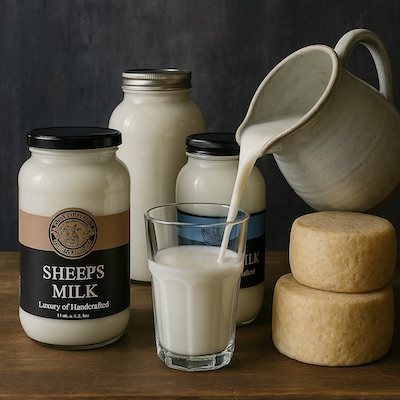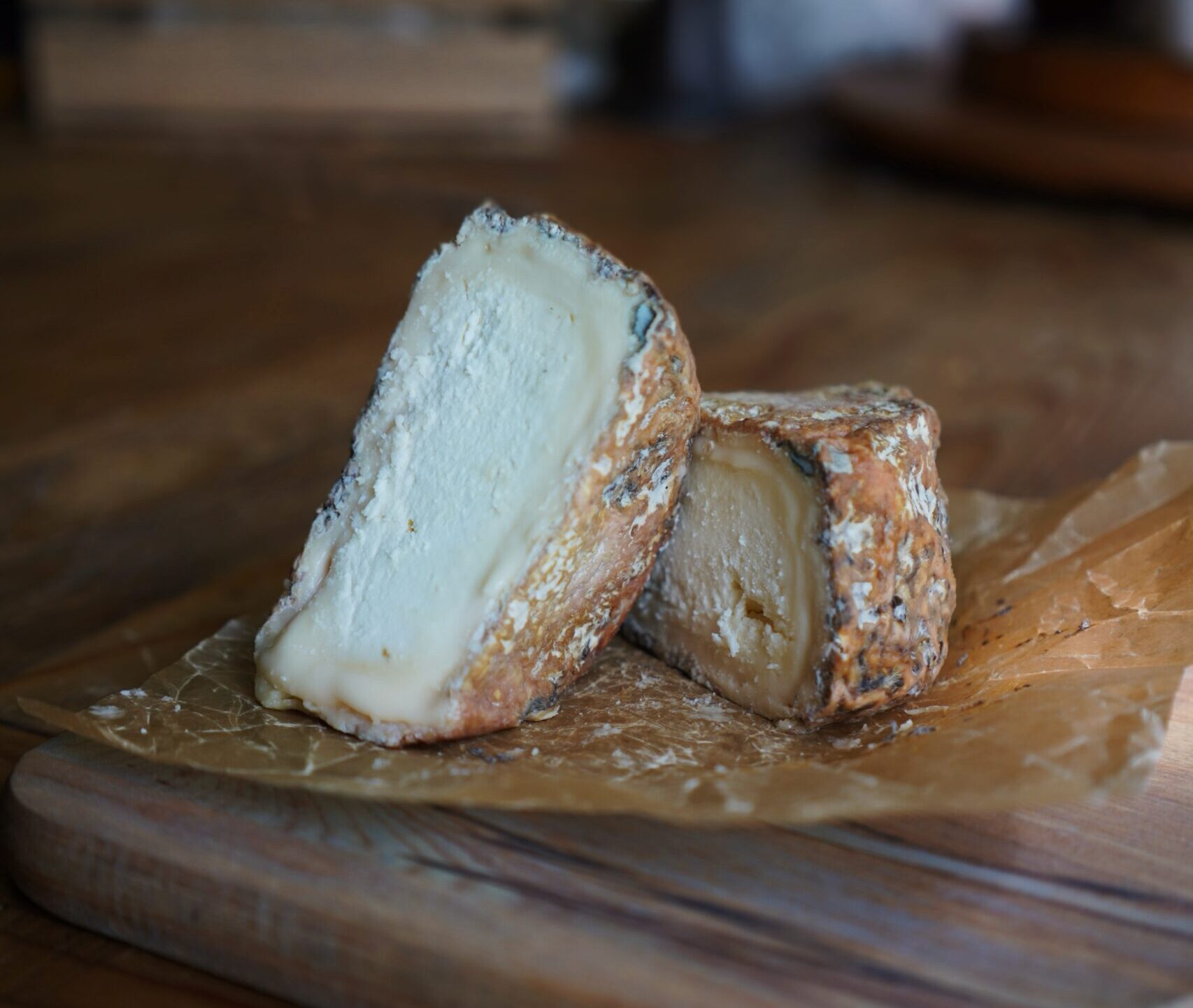We’ve been making Tommette de Brebis for years now – in fact, it was one of the first soft cheeses we dared to try after establishing our sheep dairy. Yet, even with all that experience, this little cheese continues to surprise us. I remember the very first successful batch we made; we were astonished that we had created something that tasted like a fine French farmstead Brie but with our own twist. We had that “aha!” moment! The rind bloomed perfectly, the center went creamy, and the flavor was heavenly. We’ve been hooked ever since.
Fast forward through many seasons and many batches, and we still approach each batch of Tommette with excitement. We often cut into a new batch and look at each other with wide eyes, “Oh wow, you taste that note of truffle?” or “This one has a crazy buttered mushroom flavor!” There’s a continuous sense of discovery. In a way, the cheese is our teacher. It reminds us that, as much as we have learned, there are always more nuances to uncover.
This enduring element of surprise is a big part of why we love making Tommette de Brebis. It’s never dull or rote. There’s an honest dialogue between us and the cheese. And our customers feel it too – some who buy it regularly will tell us, “I liked the last one, but this new batch? I think it’s even better!” or “I noticed this wheel was creamier than the previous one.” It makes the experience of enjoying the cheese more engaging. You become a participant in the cheese’s story, not just a passive consumer. We have a few patrons who have practically become Tommette connoisseurs, noting the differences and having their personal favorite batches.
Importantly, through all these variations, Tommette de Brebis remains a gentle, approachable cheese. We like to describe it as a “friendly” introduction to the world of mold-ripened cheeses. Some people are intimidated when they see a fuzzy, colorful rind or hear the word “mold”. We understand – it can sound exotic or even scary if you’re used to rubbery supermarket cheese. But one bite of Tommette usually changes their mind. The flavor is mild and creamy, especially when the cheese is younger. Unlike some strong-smelling washed-rind cheeses or pungent blue cheeses, a bloomy-rind cheese like Tommette has a delicate aroma. The mold is all on the exterior, acting as a protective coat and flavor enhancer. But it doesn’t infiltrate the paste with intense moldy veins or anything like that. The inside of the cheese stays pure, sweet, and white.
We often explain that the rind is edible and contributes a subtle flavor, like a mushroom or a yeasty bread crust. If someone is hesitant, we tell them, “Give it a nibble along with the creamy interior – it’s nature’s perfect pairing.” In fact, that edible rind is considered a delicacy by cheese lovers. It’s soft, not papery or hard. And when a soft cheese like this is in good condition, the rind’s flavor is usually very mild – sometimes almost undetectable beyond a slight earthiness. Many times we’ve heard, “Oh, the rind doesn’t taste like much – it’s good!” Yes! That’s how it should be: it complements but doesn’t overpower. (If a Brie-type cheese is overripe, the rind might get ammoniated and unpleasant, but we never sell our Tommette in that state. We keep an eye to ensure it’s enjoyed at its peak).
In our view, Tommette de Brebis is an excellent gateway cheese for someone looking to explore beyond Cheddar and Mozzarella. It offers the experience of a mold-ripened cheese – the soft velvet rind, the creamy flowing interior, the nuanced aromas – but in a very gentle form. It’s smaller and milder than, say, a traditional Camembert which can have a more intense “funk” as it ages. Our sheep’s milk also adds a sweetness that balances the mushroomy notes. We’ve had many self-proclaimed “non-adventurous” eaters try Tommette at a farmers’ market sampling, and watch their eyes light up in surprise. “This is moldy cheese? It’s so good!” is a common reaction. We just smile and welcome them to the fold of cheese appreciation.
Another reason Tommette is a great introduction: its size. It’s a petite wheel, which means if you’re trying it for the first time, it’s not as daunting as buying a big wheel. You can enjoy our Tommette over a couple of sittings. And psychologically, I think a little round cheese just looks cute and inviting rather than scary.
We take pride in the fact that we’ve been making Tommette de Brebis for years and it still delights not just our customers, but even us, the cheesemakers. Sometimes, late in the day after we’ve cleaned up the make room, we’ll walk into the aging cave just to check on the cheeses. We’ll hold a Tommette in my hand, feeling its soft rind, and I’m hit with a moment of gratitude. This cheese has come a long way – from our sheep in the barn, through careful crafting, and weeks of tender aging – and it’s alive and blooming. It’s both consistent (in quality) and ever-changing (in character). What a wonderful thing that is.
To sum up this section: after years of making Tommette de Brebis, we’re still enamored with it. It keeps us humble and curious as makers. And for our customers, it’s become a beloved cheese that offers a gentle adventure in mold-ripened style. It’s artisanal yet approachable. If you’ve read this far and haven’t tried it yet, we hope you’re feeling inspired (and maybe a bit hungry!). You can even pre-order your wheel of Tommette de Brebis! But how should you enjoy it exactly? Don’t worry – in our final section, I’ll share some favorite ways to serve and savor Tommette de Brebis in daily life.
Enjoying Tommette de Brebis: Serving & Pairing Ideas
One of the joys of a cheese like Tommette de Brebis is how versatile it is in everyday enjoyment. This isn’t a cheese you need to save for only fancy occasions. Though it indeed can star on an upscale cheeseboard. We encourage you to treat yourself to it on a casual weeknight, a sunny picnic, or as a special breakfast treat. Here are some ideas and tips from us at Secret Lands Farm on how to get the most out of your Tommette de Brebis.
Bring it to room temperature: This is a general rule for most cheeses, but especially soft ones. Take the Tommette out of the fridge at least 30 minutes (or even an hour) before you plan to eat it. Let it breathe on a plate at room temperature. Why? The cheese will soften up, and the flavors and aromas will bloom wonderfully. Cold temperatures muffle the taste and make the texture firmer. When warmed slightly, Tommette becomes decadently creamy, and the full flavor comes forward – a world of difference. As one cheese expert says, enjoying these cheeses at room temperature is essential. The experience is “vastly different,” and you’d be missing out otherwise. So resist the urge to eat it straight from the cold – patience will be rewarded!
Eat the rind (or at least give it a fair chance): We’ve touched on this, but it’s worth repeating when serving. The rind of Tommette is not only edible, it’s a key part of the flavor profile. When you serve the cheese, there’s no need to cut the rind off – in fact, leaving it on helps the cheese hold its shape when slicing or spreading. Encourage guests (or family members) to try a bit of the cheese with the rind included. Often, they’ll find it delicious and complementary. The rind brings those gentle earthy, mushroomy notes that balance the creamy interior. It’s what makes the whole bite more interesting. So yes, rind on! – it’s “nature’s complement to the paste of the cheese,” as one guide nicely put it. Of course, if someone is truly rind-averse, they can peel it, but we think that’s leaving behind a lot of goodness.
Serving ideas: Tommette de Brebis can be enjoyed simply or incorporated into dishes. Here are some of our favorite ways:
- On a cheese board: This is a natural. Place a whole Tommette on your cheeseboard as the delicate bloomy-rind option. Surround it with some fresh or dried fruits and nuts. For example, we love it with seedless grapes, slices of crisp apple or pear, or dried apricots. Nuts like almonds, walnuts, or pistachios provide a nice crunch contrast. You can serve a small jar of honey or fig jam on the side – a little dollop of something sweet on a bite of Tommette is heavenly. The sweetness enhances the milk’s sweetness in the cheese, and the saltiness of the cheese highlights the honey/jam. A classic pairing is Brie (or Tommette) with honey and walnuts – try it on a slice of baguette and you’ll see why it’s a classic. Our customers also rave about a dab of red pepper jelly or a tart cherry preserve with this cheese.
- With bread or crackers: A fresh baguette is basically Tommette’s best friend. Tear off a piece of baguette, spread some soft Tommette on it, and enjoy – simple perfection. Crackers work too; choose a mild cracker that isn’t too salty or flavored, so the cheese remains the star. Water crackers, buttery rounds, or even those nice fruit-and-nut crisps all can pair nicely. For a rustic touch, try rye bread or sourdough – the tang of sourdough is actually lovely with the creamy sheep cheese.
- Melt it or bake it: Because Tommette is small, you can do a mini baked Brie-style preparation with it. For a quick indulgent appetizer, take a Tommette, place it in a small oven-proof dish, top with a spoonful of apricot jam or cranberry sauce and some chopped pecans, and bake at 350°F (175°C) for about 5-7 minutes until it’s soft and gooey. Scoop it up with bread – it’s an instant crowd-pleaser. (Keep an eye on it; because it’s smaller than a typical Brie, it will melt faster). You can also remove the top rind and bake it with a drizzle of garlic-infused olive oil and herbs for a savory twist.
- In sandwiches and more: Tommette’s creamy nature makes it great for spreading in sandwiches or wraps. I adore a baguette sandwich with Tommette, some thin slices of prosciutto, and peppery arugula – it’s like a gourmet picnic sandwich. It also elevates a grilled cheese: use Tommette with something like a ham or roasted veggies in a panini press, and the cheese will melt into a luscious, oozy filling. Another idea: slice a bit onto a burger right after cooking. It will soften into the patty, adding a tangy richness (sheep brie burger, anyone?). Even in breakfast, you can be creative. For example, make a creamy Brie-style omelet by melting bits of Tommette into eggs with some chives.
Beverage pairings: Now, what to drink with Tommette de Brebis? There are many good options since this cheese isn’t too aggressive; it plays well with various wines and beers. A general tip: opt for beverages that are not overly heavy or tannic, allowing the cheese to shine. Here are some pairings we love:
- Sparkling wine: If we had to pick one perfect match, a dry Champagne or sparkling white would be it. The effervescence and acidity of a brut Champagne or a good Cava cuts through the creamy fat of the cheese, cleansing your palate between bites. The lightness and bubbles refresh, so you can keep enjoying the richness without feeling overwhelmed. This is a classic pairing in France – Brie and Champagne – and it holds for our sheep Brie too. The subtle fruity and toasty notes in the bubbly also complement the nutty, earthy tones of the cheese.
- White wine: Look for a Sauvignon Blanc or a Riesling. A zesty Sauvignon Blanc (especially a Loire Valley Sancerre or a New Zealand sauvignon) has bright acidity and herbal citrus notes that contrast nicely with the cheese’s creaminess. A dry or off-dry Riesling brings a touch of stone fruit sweetness and high acidity, which can marry beautifully with the cheese (and any fruit accompaniments). Both wines are light enough not to overpower. Another white to consider is Chardonnay, particularly an un-oaked or lightly oaked one. A Chablis (unoaked Chardonnay) has a steely acidity and minerality that can be superb with Tommette’s lactic flavors. If you prefer a richer white, a creamy Brie-style cheese with a creamy, buttery California Chardonnay can be a voluptuous combo – just ensure the wine’s oak and vanilla don’t completely mask the cheese’s subtleties.
- Red wine: For reds, lighter is better. A Pinot Noir is a classic choice with Brie-type cheeses. The soft tannins and red fruit of a Pinot (especially from Burgundy or Oregon) complement without dominating. It’s a mellow partnership – the wine’s cherry/berry notes play with the cheese’s sweetness, and its earthiness echoes the rind’s earthiness. Another lovely red is Barbera or a young Beaujolais (Gamay grape). These are fruit-forward, low-tannin wines that have enough acidity for cheese. We’ve also enjoyed Tommette with rosé wine, particularly in the summer – a dry Provençal rosé, chilled, with its hints of strawberry and herbs, can be delightful alongside the cheese and some fresh berries.
- Beer and other drinks: If you’re a beer person, try a farmhouse ale or Belgian saison with Tommette. The mild funk and carbonation of a saison complement the earthy rind and cleanse the palate. A light wheat beer or a pilsner can work for a simpler beer choice – they won’t overpower the cheese. Also, hard apple cider is a fantastic pairing! Cider has sweetness and acidity that go hand in hand with sheep cheese (think of apple slices and cheese – same idea, but in beverage form). Lastly, for a non-alcoholic route, a cold-brewed sparkling apple or pear juice, or even a kombucha, could be interesting – anything with a bit of acidity and fruit.
Everyday uses: Beyond pairings, we encourage you to get creative. One customer told us she chopped up a bit of Tommette and added it to a salad of roasted beets, walnuts, and arugula – essentially using it like you would use goat cheese in a salad. She said it was incredible because the Tommette chunks added little pops of creamy, tangy flavor throughout. Another family reported making sheep Brie pizza – after baking a flatbread, they topped it with thin slices of Tommette, prosciutto, and arugula so that the residual heat just melted the cheese slightly. That’s quite gourmet!
And of course, there’s nothing wrong with simply enjoying it as a snack on its own. Sometimes in the evening, I’ll just cut a wedge of Tommette and eat it plain, appreciating the flavors slowly. It pairs well with a cup of tea too, believe it or not – I like a mild black tea or an oolong with it if I’m not in the mood for wine.
To wrap up, here are a few serving tips to make the experience even better:
- Use a cheese knife or butter knife and cut small wedges. Or even just dig in with a spoon if it’s very creamy. There’s no wrong way, but etiquette for a round like this is to cut pie-like wedges so everyone gets some rind and some interior.
- If you want a beautiful presentation, you can decorate the top of the wheel. For instance, placing a clean edible flower or a sprig of rosemary on top of the white rind looks lovely (do this just before serving).
- Leftovers (if any!): Wrap any remaining cheese in wax paper or parchment (avoid airtight plastic wrap as the cheese still needs to breathe) and keep it in a container in the fridge. It should last several more days, continuing to ripen slowly. If it gets a bit stronger, you can always bake it as mentioned.
Finally, we’ll say this: the best way to enjoy Tommette de Brebis is with good company. Food, especially a personal artisan cheese like this, is meant to be shared and savored. Whether it’s with family at your table, or you’re telling a friend about this cool sheep cheese you discovered, we hope Tommette brings a sense of connection and pleasure to your daily life.
In conclusion, Tommette de Brebis is more than just a cheese to us. It’s a story, a tradition, and a little piece of our farm that we offer to you. It embodies the rich heritage of soft-ripened cheeses while carrying our own farm’s fingerprint through natural cheesemaking and sheep’s milk goodness. From the science of molds and A2 proteins to the art of affinage and the joy of tasting, we’ve poured our passion into every wheel. And we’re still learning and marveling with each batch. We invite you to taste this journey for yourself.
Enjoy Tommette de Brebis with an open mind and curious palate – perhaps with a glass of something bubbly and a dollop of honey – and experience how a small bloomy-rind sheep cheese from Secret Lands Farm can capture so many of the things we treasure: tradition, nature, and the simple pleasure of delicious food made with love. Bon appétit!
Sources:
- Secret Lands Farm – Tommette de Brebis product description secretlands.ca
- Cheese Grotto – What is Bloomy Rind Cheese? (mold cultures and origins) cheesegrotto.com
- David Asher, The Art of Natural Cheesemaking – advocacy of natural cultures over freeze-dried chelseagreen.com
- The Fermentary – Discussion of David Asher’s kefir-based method (“re-wilding” milk) thefermentary.com.au
- GardnersWisconsinCheese.com – The Art of Cheesemaking (artisan batch variation) gardnerswisconsincheese.com
- Spruce Eats – Brie vs Camembert flavor comparison thespruceeats.com
- WineTravelista – Wine Pairing Guide for Brie (sparkling wine and light reds) winetravelista.com




